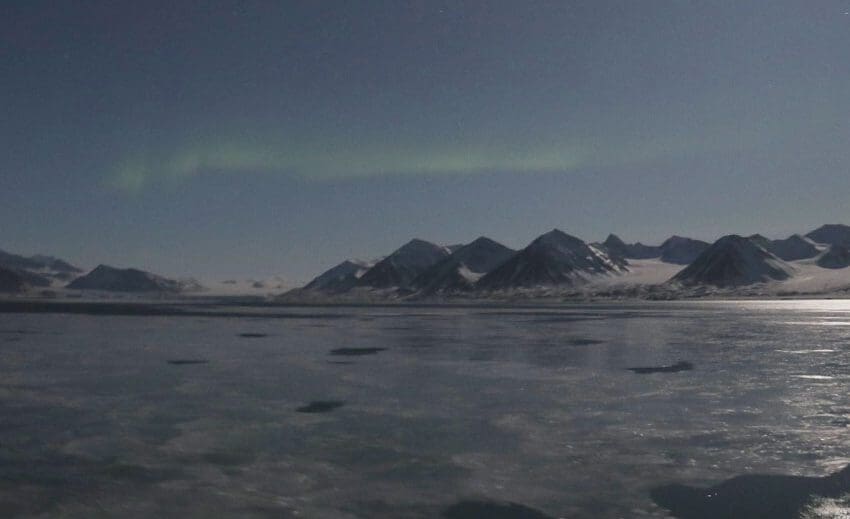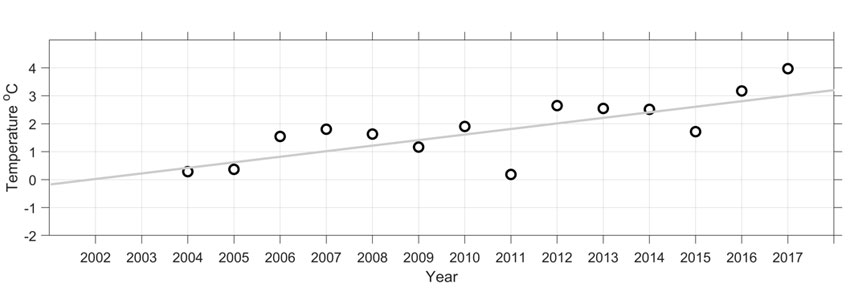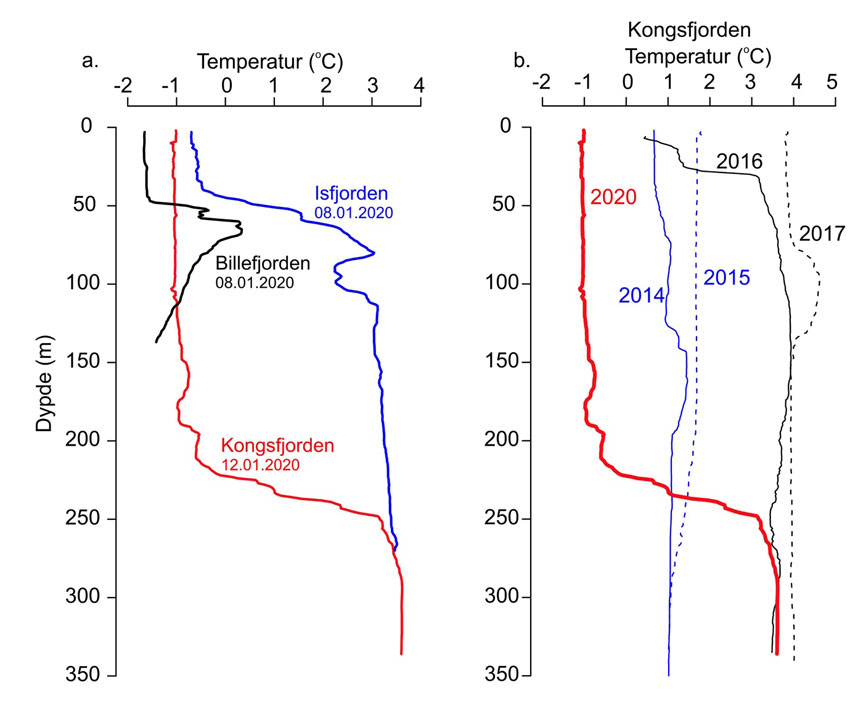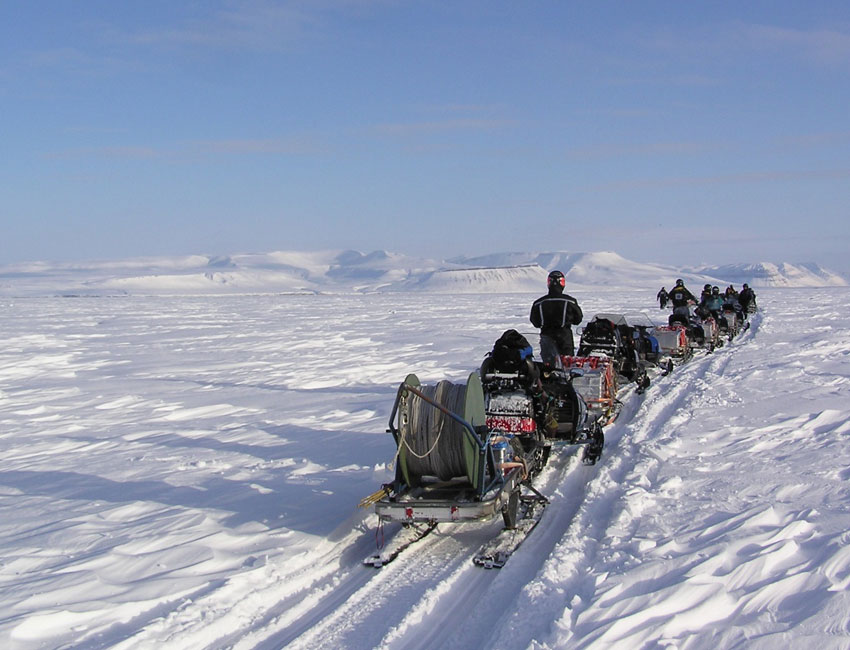Ice in sight!

Top image: Kongsfjorden in clear weather, moonlight, northern lights and newly frozen sea ice. Photo: Malin Daase.
We are on a polar night cruise and measurements we have taken show that both Isfjorden and Kongsfjorden are almost five degrees colder now in 2020 than it was at the same time in 2017, and the fjords are simply freezing around us!
20 January 2020
Text: Professor Jørgen Berge (UiT – The Arctic University of Norway, UNIS and NTNU), Dr. Malin Daase (UiT Norway’s Arctic University) and Dr. Janne E. Søreide (UNIS).
We are currently out on a polar night cruise with the research vessel “Helmer Hanssen”. This is the ninth year we have traveled in the area at this time of year. Although we are mainly biologists on board who study biological processes in the dark, we also make routine measurements of temperature in the fjords. The measurements show that both Isfjorden and Kongsfjorden are almost five degrees colder now in 2020 than it was at the same time in 2017, and the fjords are simply freezing around us!
In 2002, the Scottish Association of Marine Science (SAMS) and the Norwegian Polar Institute established a marine observatory in Kongsfjorden. The observatory was open for the first year only during the summer, but as early as autumn 2003 it was continued in collaboration with UNIS. From 2005 until today, the observatory has been a collaboration between UNIS, UiT- The Arctic University of Norway and SAMS. From 2018, the observatory became an integral part of the national research infrastructure SIOS. During this period, we have only measured one year (2011) temperatures that are about as cold as now. Given the people in Longyearbyen wanting to go on scooter trips, this is probably very good news.

In the winter of 2005-06 we got the first of several episodes where relatively warm Atlantic water from the Gulf Stream system on the shelf outside entered the fjords on the west coast. This caused the temperature to rise significantly in the winter that year, and the fjord remained well above freezing for five winters in a row. In 2011, Kongsfjorden was again relatively cold, while the fjord in all years after this has had temperatures partly well above freezing in winter.
Unfortunately, the observatory was destroyed in January 2019, which means that we lost data from the period August 2018 to January 2020. We therefore do not know for sure when and how strongly the cooling has taken place, but UNIS’s measurements from Isfjorden indicate that at least Isfjorden has cooled down to 1-1.3C only since November 2019, and that the cold surface layer still lies as a lid over the warmer Atlantic water.
The Kongsfjorden observatory is now back in operation after it was launched on this year’s polar night cruise, and will hopefully continue to be able to provide good and important measurements of sea temperature, light and time of the plankton spring bloom in the future.
Regardless of the underlying mechanisms, Kongsfjorden is now considerably colder than it has been during the same period in the years 2014-2017 (in 2018 and 2019 the annual cruise did not enter the fjords on Svalbard). In Isfjorden we now have temperatures of about -1C in the upper 40m of the water column, while in Billefjorden it is -1.8C down to 50m (sea water freezes at -1.8C). In Billefjorden, the ice has already started to settle well towards Skansen, although it broke up somewhat and blew out of the fjord during the storm. There were some questions on Facebook about Helmer Hanssen breaking up the ice, but we actually didn’t – we worked on the ice edge and were only a few feet into the ice (which was only about 5cm to a maximum of 10cm in thickness on the outer edge). Below 50m we still find the relatively warm Atlantic Ocean water throughout Isfjorden. In Kongsfjorden the temperature is actually down to -1.2C in the upper 200m, and the fjord is freezing in several places around the boat where we work. We find the warm Atlantic water only below 250m deep.

The last time Isfjorden was properly frozen was the winter of 2004-05. That year we went on fieldwork from UNIS to Billefjorden with snow scooters over the sea ice around Revneset and all the way in to Adolfbukta. Whether there will be a similar ice cover this year remains to be seen, but it is doubtful. However, there are clearly good opportunities for relatively large parts of both Isfjorden and Kongsfjorden to freeze. Seawater freezes as is known at -1.8C, and there is already a thick layer of cold water that insulates against the heat in the Atlantic water below (Figure A). So even though it still takes a longer cold (and quiet) period before it is possible to drive scooters over to Blomstrand or Skansen, at least the conditions are good for the new decade to start with a winter where the fjords are once again covered in ice. Unfortunately, the climate crisis is not canceled with this, as we are talking here about local conditions and processes. But we hope we can take a trip over safe sea ice this coming winter!
